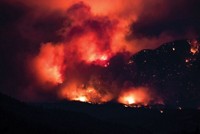Advertisement
Grab your lab coat. Let's get started
Welcome!
Welcome!
Create an account below to get 6 C&EN articles per month, receive newsletters and more - all free.
It seems this is your first time logging in online. Please enter the following information to continue.
As an ACS member you automatically get access to this site. All we need is few more details to create your reading experience.
Not you? Sign in with a different account.
Not you? Sign in with a different account.
ERROR 1
ERROR 1
ERROR 2
ERROR 2
ERROR 2
ERROR 2
ERROR 2
Password and Confirm password must match.
If you have an ACS member number, please enter it here so we can link this account to your membership. (optional)
ERROR 2
ACS values your privacy. By submitting your information, you are gaining access to C&EN and subscribing to our weekly newsletter. We use the information you provide to make your reading experience better, and we will never sell your data to third party members.
Climate Change
Climate talks seek to fend off double counting of emission cuts
Negotiators in Madrid craft rules for emission trading system
by Cheryl Hogue
December 2, 2019

A blunder that accountants and economists take pains to avoid is double counting – counting the same costs or benefits more than once. This kind of error can stem from bad arithmetic or it may, in the case of fraud, be intentional.
Double counting is on the mind of climate change negotiators meeting in Madrid Dec. 2-13. They are working out the details for an international market-based system for trading greenhouse gas emission credits.
In climate talks last year in Poland, governments established most of the rules that will guide nations as they fulfill pledges to control greenhouse gas emissions. Countries rich and poor made those commitments in the 2015 Paris Agreement to combat human-caused climate change.
But the gathering in Poland ended without agreement on rules for emission trading. This system would allow a country that cuts its releases of greenhouse gases to sell credits for doing so to another nation.
Such swaps are intended to reduce the cost of reducing emissions worldwide, help countries meet their Paris Agreement goals, and promote sustainable development, South Africa negotiator Mandy Rambharos says. Emission trading is seen as imperative to attract private investment in emission-cutting projects.
Now, Rambharos and other negotiators gathered in Madrid are trying to resolve thorny issues on emission trading. They hope to pave the way for a second round of emission pledges in 2020 that entail steeper cuts than those promised under the Paris Agreement.
The talks come after a United Nations report in late November warned that the world is heading for a 3.2 °C average rise in average global temperature over preindustrial levels by 2100. Many scientists say such an increase would be catastrophic. The Paris Agreement sets a policy goal to restrain that increase to “well below” 2 °C and urges countries to limit warming to 1.5 °C.
Negotiators hammering out the emission trading rules in Madrid face several challenges, says Kelly Levin of the World Resources Institute, a think tank based in Washington, DC. Perhaps the biggest is determining how to avoid double counting – having the country that cuts emissions and its trading partner both get credit for the reduction.
Preventing this will involve requirements for transparency – some sort of public disclosure about the trades and how they’re being counted, says Erika Lennon, a senior attorney at the Center for International Environmental Law.
Another challenge is ensuring that trades produce emission reductions that would not have happened in the absence of trading. This in part means that the rules will have to be detailed enough to ensure that emissions aren’t simply shifted from one country to another, Lennon says.
Overall, the trading system is supposed to create incentives for countries to take on deeper emission cuts and to implement climate change adaptation projects. A set of weak rules with loopholes will lower countries’ ambitions for addressing climate change, Lennon says.





Join the conversation
Contact the reporter
Submit a Letter to the Editor for publication
Engage with us on Twitter